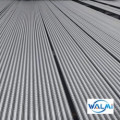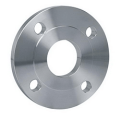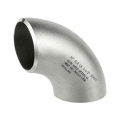Stainless Steel Pipes and Fittings: A Symbol of Quality and Reliability
In modern industry and construction, stainless steel pipes and fittings, with their superior performance and wide application, have become an indispensable component of piping systems. Today, let’s explore the world of stainless steel pipes and fittings, learning about their characteristics, applications, and why they are the preferred choice across numerous industries.
I. Unique Advantages of Stainless Steel Pipes and Fittings
The popularity of stainless steel pipes and fittings stems primarily from their excellent corrosion resistance. Stainless steel contains alloying elements such as chromium, which form a dense oxide film on its surface, effectively preventing corrosion from oxygen and moisture. This allows for long-term, stable operation in harsh environments, significantly extending the lifespan of piping systems.
Stainless steel pipes and fittings also possess high strength and excellent toughness. They can withstand high pressures and temperature fluctuations without deformation or cracking, ensuring the safety and reliability of piping systems during operation. Furthermore, the smooth surface of stainless steel resists the growth of bacteria and dirt, making it easy to clean and maintain, meeting hygienic standards, and widely used in industries with stringent hygiene requirements, such as the food and pharmaceutical industries.
II. Wide Range of Applications
Stainless steel pipes and fittings have an extremely wide range of applications. In the construction industry, it’s commonly used in water supply and drainage systems, fire protection systems, and HVAC systems, providing stable and reliable pipe connection solutions for buildings. In industrial production, the petroleum, chemical, and power industries place extremely stringent requirements on piping systems. Stainless steel pipes and fittings, with their corrosion resistance and resistance to high temperatures and high pressures, are ideal for conveying a variety of fluids.
As we see in the video, those neatly stacked wooden boxes likely contain carefully packaged stainless steel pipes and fittings, ready to be shipped to the construction sites and factories where they’re needed, contributing to various projects. And those large elbows and other fittings, wrapped in plastic film, will soon play a vital role in their respective roles, connecting pipe sections and building complex pipeline networks.
3. Strict Production and Quality Control
To ensure the quality and performance of stainless steel pipes and fittings, strict standards and specifications must be adhered to during the production process. Starting with the selection of raw materials, it’s crucial to ensure that the stainless steel meets relevant standards and possesses excellent chemical composition and mechanical properties. During the production and processing stages, advanced processes and equipment are employed to precisely control the size, shape, and surface quality of the pipes and fittings.
Strict quality inspection is also essential. Each batch of pipe fittings undergoes multiple tests, such as chemical composition analysis, mechanical property testing, and non-destructive testing, to ensure they meet quality requirements. Only fittings that pass these rigorous inspections are released to the market, providing reliable assurance for customers.
4. Choosing the Right Stainless Steel Pipe Fittings
When selecting stainless steel pipe fittings, multiple factors should be considered. First, choose the appropriate stainless steel material, such as 304 or 316 grades, based on the specific operating environment and working conditions to meet varying requirements for corrosion resistance and high-temperature resistance. Second, select fittings with the appropriate specifications and models based on the piping system’s parameters, such as pressure, temperature, and flow rate, to ensure safe and stable operation.
Furthermore, selecting a reputable and reputable supplier is crucial. A high-quality supplier not only provides high-quality products but also offers professional technical support and after-sales service to help customers resolve any issues encountered during use.
Stainless steel pipe fittings, with their unique advantages and wide application, have become an indispensable part of modern industry and construction. Whether it’s the water supply and drainage systems of high-rise buildings, chemical pipelines in factories, or sanitary pipes in the food and pharmaceutical industries, stainless steel pipes and fittings are silently playing an important role, providing solid support for the development of various industries. When we see those neatly stacked pipes and fittings, we might as well imagine the key role they will play in future projects and how they will bring convenience and security to our lives and work.




